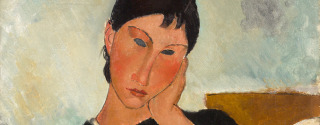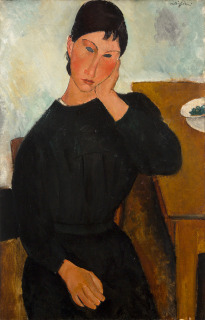Amedeo Modigliani. A painter and his dealer

Elvire assise, accoudée à une table, 1919
Saint-Louis, Saint Louis Art Museum
don de Joseph Pulitzer Jr. en mémoire de sa femme, Louise Vauclain Pulitzer, 77:1968/ Image Courtesy of the Saint Louis Art Museum
Amedeo Modigliani. A painter and his dealer
Just over a century after the two men met in 1914, Modigliani and His Art Dealer looks back at one of the most significant moments in the life of the artist Amedeo Modigliani (1884-1920), when the Parisian Paul Guillaume (1891-1934) became his principal art dealer. The exhibition explores how the relationship between these two figures can shed light on the artist’s career and his posthumous fame. Amedeo Modigliani, an Italian artist of Jewish origin who arrived in the French capital in 1906, painted and sculpted in the vibrant environment of the Ecole de Paris.
Shortly after his first patron, the doctor, Paul Alexandre, left for the front in 1914, Modigliani met a young art dealer, Paul Guillaume, who would become his gallerist towards the end of 1915. The painter and the dealer frequented the capital’s artistic and literary circles and shared a taste for poetry and for non-Western cultures. During the years of World War I, the dealer’s apartment-gallery contained numerous canvases by Modigliani. Paul Guillaume encouraged the artist and endeavoured to promote and sell his works. Even after Modigliani met his other supportive dealer the Polish Léopold Zborowski in 1916, Paul Guillaume continued to champion and distribute Modigliani’s works in France and across the Atlantic until his death in 1934.
The exhibition brings together some of the great artworks by the artist that passed through the hands of Paul Guillaume , as well as archives and documents, which testify to their relationship. All the works presented here have a direct connection to Guillaume: they either belonged to him, were sold by him or were featured in his review, Les Arts à Paris.
Amedeo Modigliani and Paul Guillaume
The gallery owner and collector Paul Guillaume is said to have met Amedeo Modigliani in 1914 through the poet Max Jacob, becoming his dealer, in all likelihood, the following year. Guillaume rented a studio for Modigliani on rue Ravignan in Paris and, in a series of now famous photographs some of which are shown in this room, the two men are seen posing in front of paintings and drawings by the artist hanging on the studio wall. Modigliani painted and drew his new dealer several times during the course of 1915 to 1916.
Of these works, three oil portraits and two drawings are displayed here. Also included are photographs of Paul Guillaume’s apartment-gallery on avenue de Villiers from 1916, where several works by Modigliani can be seen. In addition to the five Modigliani paintings now in the Musée de l’Orangerie, over a hundred canvases are reputed to have passed through Paul Guillaume’s hands during his lifetime, as well as some fifty drawings and a dozen sculptures. This high number indicates both the dealer’s involvement in promoting the artist and also reflects his personal taste for the Italian’s artworks.
Masks ans heads
For a brief but intense period between 1911 and 1913, Modigliani focused almost exclusively on carving. Alongside his sculptural works, he made several elegant drawings. The simplified forms that characterize these was to inform the fragmented or elongated style of his wartime paintings, such as the female heads also shown in this gallery. Visits to Paris museums, including the Louvre and the Musée d’Ethnographie du Trocadéro (across the river from the Eiffel Tower), had inspired Modigliani, and countless other European artists, to look at Egyptian, Khmer, African and early Italian art.
Guillaume was one of the few dealers of his day to treat African statues and masks as works of art and among the first to show these works alongside examples of modern European artworks. Although Modigliani was no longer carving by the time Guillaume became his dealer, this did not stop the young Parisian from buying some stone or marble heads by Modigliani and selling them to important clients, such as Albert C. Barnes, the collector from Philadelphia, after the artist had died in 1920.
Parisian milieu, artistic and literary affinities
In 1906 Amedeo Modigliani arrived, aged 21, in cosmopolitan Paris, the capital of the arts, and began a remarkable artistic journey. This cultural crossroads, so vibrant at the beginning of the 20th century, provided him with artistic contacts in the fields of painting, literature and commerce, fertile ground in which to develop his artistic vision. The figures of those closest to him populate his paintings, providing an astonishing panorama of personalities of the period: Constantin Brancusi, Chaïm Soutine, Moïse Kisling, Juan Gris, Jacques Lipchitz, Jean Cocteau, Léopold Survage, Pablo Picasso, Diego Rivera, Max Jacob and Beatrice Hastings, painted alongside figures known only by their first names or who now remain anonymous.
Discharged for health reasons, neither Modigliani nor Paul Guillaume went to the front in the First World War. They remained in Paris, frequenting a similar social milieu. Modigliani, who had lived between Montmartre and Montparnasse since his arrival, remained one of the informed witnesses and participants in the active Parisian arts scene.
Southern period
With the support of a new art dealer, Léopold Zborowski, Modigliani returned to painting the female nude in 1916. If Modigliani made these paintings for male buyers, their sensuality suggests the growing emancipation of women of a certain social class, in the 1910s. These images proved shocking and in 1917, when some were included in Modigliani’s only lifetime solo exhibition, they were removed on the grounds of indecency, as they displayed the models’ pubic hair. Traditionally, in fine art, nudes were hair-free. From Guillaume’s album of works by Modigliani, we know that he acquired and sold at least two nudes after the artist’s death. This relatively small number may be connected to Zborowski’s personal investment in these works, which made it difficult for Guillaume to source them for sales. In the last months of the World War I, with Paris suffering air raids and with Modigliani’s health growing worse, Zborowski, sent his artist to the French Riviera. Modigliani was anxious about the move, however, given the number of his city friends who had also headed south, he would still find plenty of company. His new partner, the painter Jeanne Hébuterne who was already pregnant with the couple’s first child also went.
Modigliani made some of his strongest works in Nice, painting portraits of local children, servants and other anonymous sitters and even trying his hand at landscapes. Guillaume bought and sold several of these important works during the 1920s, some of which are included in this gallery
